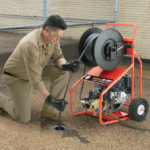By Dave Dunbar
Roots are your sewer pipes’ worst nightmare! As we pointed out in part one of this blog, tree roots are constantly hungry and thirsty, searching relentlessly for water and nutrients. Both are abundantly available inside the drainpipes that lead from our homes to the septic systems or municipal sewage treatment plants that process our waste.
Root hairs are tiny, sometimes thinner than human hair, but they grow quickly and, as we discussed, can sense the vibration of running water from a great distance. They grow and expand when they squeeze through a small crack or crevasse in a drainpipe and find what they seek. Over a period of months and years, this unrelenting pressure on the pipe expands the initial crack and causes serious damage. Before you know it, a tree root is blocking your drain, and the pipe leaks like a sieve. When a plumber or drain cleaner encounters a pipe in this condition, ignoring the problem is not an option. Here are several strategies that a professional can use to solve the problem:
Replace or Reline the Infested Pipe
If a drainpipe has lost its structural integrity, obviously, the best solution would be to replace it. When properly installed, modern plastic pipes will be far more waterproof and durable than what is in the ground at present. Or, if digging a trench through the customer’s property is not the most convenient solution, many pipe-relining products and strategies are almost as good. Because replacing or relining is a foolproof solution to the root-incursion problem, many municipalities across North America mandate replacing leaking pipes whenever the property changes hands. If this is the case, the contractor and customer must replace or reline the pipe.
Drain Cleaning Machine
Although replacing or relining the pipes is the preferred solution, a cable-style drain cleaning machine like General Pipe Cleaners’ Speedrooter 92, in combination with a ClogChopper cutter, is the most commonly used method of removing and cutting roots. Much of this has to do with cost and expediency. The customer is usually rewarded with a functioning drainpipe for a few hundred dollars and two hours’ time. Contrast this with enduring several messy construction days and perhaps tens of thousands of dollars for a pipe replacement job. It is a small wonder that, after doing the math, customers continue to pick the drain cleaning option even though it does not fix the underlying problems that allowed the root incursion in the first place. Any cracks, crevices, or separations in the pipe before using the snake are still there. These openings induce more root incursion and allow the inflow of rainwater, which contributes to sewage overflows into our rivers, lakes, and oceans. At best, snaking a drain to remove root incursions is a temporary solution. However, as we will see, there are things a contractor can do to increase the effectiveness of this option.
High-Pressure Water Jetters
A high-pressure water jetter, like the drain snake mentioned above, can perform many of the same functions. It has become the go-to tool for many professionals for issues in any large drain. Like a cable-style drain cleaning machine, jetters can mechanically remove roots from the inside of a pipe.
First, there are chain saw nozzles that convert the kinetic energy of the high-pressure water generated by the pump to spin a chain saw nozzle at the end of the hose. These chain saws can rotate up to 10,000 RPM, enough to buzz through the toughest root incursions. In addition, a high-performance nozzle can often do the trick if the pipe isn’t completely filled with wood. These jetter nozzles are designed with the same technology used to make nuclear submarine propellors and convert almost 100 percent of the water’s energy to high-pressure streams that cut like razors.
Although high-pressure water jetters are also a temporary solution to root incursion, they have the advantage of preparing the pipe for more thorough inspections or pipe relining. When a professional gets done jetting a drain line, it will look like a new pipe again!
By incorporating these techniques, plumbers can proactively address root intrusion. Regular inspections and maintenance, including high-pressure water jetters, ensure that any emerging root issues are dealt with before they can cause significant damage. That way, you’re extending the lifespan of the sewer infrastructure and avoiding the disruption caused by extensive damage from those tricky roots!
Check out part three of this series, where we will discuss using flexible-shaft technology with pipe inspection systems to get the upper hand on root incursions!
For more information about how to gain the upper hand on root incursions, contact the Drain Brains at 800-245-6200 or go to www.drainbrain.com



